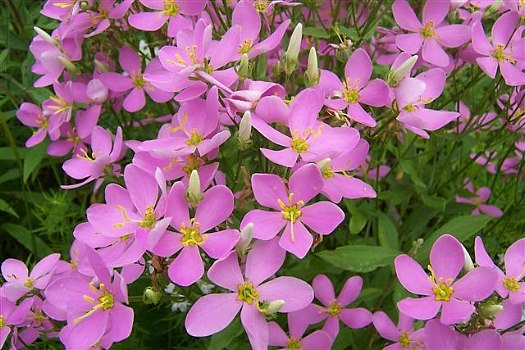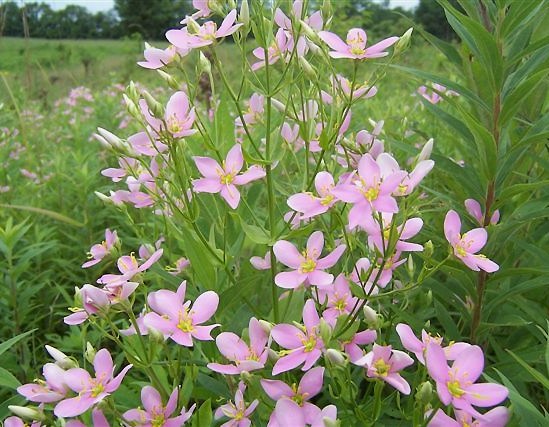Description: This biennial wildflower forms a low rosette of leaves during the 1st year, bolting into an erect plant about 1-2½' tall during the 2nd year. The central stem is 4-angled, winged, and glabrous; it is unbranched below and oppositely branched above. Opposite leaves (up to 1½" long and 1" across) occur along the stems; they are medium green, glabrous, smooth along their margins, and lanceolate to oval-cordate in shape. The leaves are sessile or slightly clasp the stems. The upper stems terminate in small cymes of flowers. The pedicels of these flowers are ½–1¼" long and glabrous. When they are fully open, individual flowers are 1-1½" across. Each flower has a corolla with 5 petals, 5 stamens with yellow anthers, a superior ovary with a divided style, and a green calyx with 5 sepals that are linear-lanceolate. The petals are obovate in shape and vary in color from rose-pink to white; they are about twice the length of the sepals. At the center of the flower, the petal bases are yellow to greenish yellow, presenting a small 5-sided star. The margins of this star are outlined in dark rose-pink. When they are receptive to pollen, the 2 linear stigmata of the style become bright yellow. The blooming period occurs from mid- to late summer. The flowers open up during the day and close at night; they are fragrant. During the fall, the flowers are replaced by single-celled seed capsules about 1/3" (8 mm.) long; each capsule contains a multitude of tiny seeds that can be blown about by the wind or float on water. The root system is shallow and fibrous.

Cultivation:
The
preference is full or partial sun and moist conditions. The soil can
contain loam, sand, silt, or some rocky/gravelly material.
Range & Habitat:
Common Rose Pink is occasional in the southern half of Illinois, while
in the northern half of the state it is rare or absent (see Distribution
Map). This plant is native to the state. Habitats include
moist prairies and sand prairies,
moist sandy thickets, marshes and sandy marshes, interdunal swales,
rocky glades, openings in rocky woodlands, sandy pits on mined land,
poorly drained fields, and roadsides. This wildflower can be found in
both degraded and higher quality habitats.
Faunal Associations:
The flowers are cross-pollinated by long-tongued bees and possibly
other diurnal insects with long mouthparts (e.g., butterflies and
skippers). Charles Robertson (1929) observed a little carpenter bee, Ceratina
dupla, and a large leaf-cutting bee, Megachile
brevis, visiting the flowers for nectar or pollen. The
caterpillars of the moth, Agyrostrotis anilis
(Short-Lined Chocolate), feed on Sabatia spp. (Rose
Pinks). Common Rose Pink is a bitter-tasting plant, but it is unclear
to what extent this may deter its consumption by mammalian herbivores.

Photographic
Location:
A prairie in Fayette County, Illinois. The photographs of the flowering
plants were taken by Keith & Patty Horn (Copyright © 2009).
Comments:
Like other species in this genus, Common Rose Pink is a showy and
attractive plant. It resembles an oversized version of Centaurium
pulchellum (Branching Centaury) from Europe, which is also in
the Gentian family. Another species, Sabatia campestris
(Prairie Rose Pink), also occurs in Illinois; it is usually found in
drier habitats. Prairie Rose Pink differs from Common Rose Pink by its
tendency to branch alternately, rather than oppositely. It also has 5
vertical ribs along the tubular portion of its calyx, while the calyx
of Common Rose Pink lacks such ribs. Other common names that have been
applied to Sabatia angularis include Rose Gentian,
Marsh Pink, and Bitterbloom.